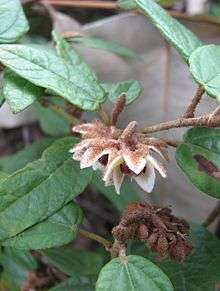Lasiopetalum macrophyllum
| shrubby velvet bush | |
|---|---|
 | |
| Scientific classification | |
| Kingdom: | Plantae |
| (unranked): | Angiosperms |
| (unranked): | Eudicots |
| (unranked): | Rosids |
| Order: | Malvales |
| Family: | Malvaceae |
| Genus: | Lasiopetalum |
| Species: | L. macrophyllum |
| Binomial name | |
| Lasiopetalum macrophyllum Graham | |
| Synonyms | |
|
Lasiopetalum dasyphyllum Sieber ex Steetz nom. inval. | |
Lasiopetalum macrophyllum, commonly known as shrubby velvet bush, is a common shrub of the mallow family found in eastern Australia.[1] Growing up to a metre tall, much of the plant is covered in rusty hairs. It is found in forest, woodland and heathland.
It was first described by Scottish botanist Robert Graham in 1841.[2] Its species name is derived from the Latin "large-leaved".[3]
Lasiopetalum macrophyllum is an (often untidy) erect to spreading shrub to 2 m (7 ft) high and 4 m (13 ft) wide. The new growth is prominently covered with red-brown hair. The leaves are oblong, lanceolate or cordate (heart-shaped) and measure 5–12 cm (2-4.8 in) long by 1–4 cm (0.4-1.6 in) wide.[1] They are either smooth or sparsely covered with fine hairs and have prominent veins on both sides; the veins are raised and rust-coloured on the leaf underside.[3] Flowering occurs August to December. The few-flowered cymes are densely covered with hair, and the calyces are rust-coloured and hairy on the outside and cream and smooth inside.[3] The hairless inside of the flowers distinguishes it from Lasiopetalum ferrugineum.[4]
The range is from central New South Wales into Victoria and Tasmania,[1] as well as islands in Bass Strait.[3] It is found in sclerophyll forest and heathland. It is often a spreading shrub in more exposed areas and taller in sheltered areas and gullies.[3] It grows on sandy soils.[5]
Lasiopetalum macrophyllum was introduced to cultivation in England in 1835. Its flushes of rust-coloured new growth have some ornamental appeal, and it grows fairly readily in part-shade in the garden, and is propagated by seed or cutting. Forms with more attractive new growth and prostrate habit have been selected for the garden. It grows in well-drained soils in sun or part shade and is frost tolerant.[3] It has also been classified as somewhat fire retardant.[6]
References
- 1 2 3 "Lasiopetalum macrophyllum". PlantNET - NSW Flora Online. Retrieved 2010-08-20.
- ↑ "Lasiopetalum macrophyllum Graham". Australian Plant Name Index (APNI), IBIS database. Centre for Plant Biodiversity Research, Australian Government.
- 1 2 3 4 5 6 Elliot, Rodger W.; Jones, David L.; Blake, Trevor (1993). Encyclopaedia of Australian Plants Suitable for Cultivation:Volume 6 - K-M. Port Melbourne: Lothian Press. p. 54. ISBN 0-85091-589-9.
- ↑ Fairley, Alan; Moore, Philip (2000). Native Plants of the Sydney District:An Identification Guide (2nd ed.). Kenthurst, NSW: Kangaroo Press. p. 81. ISBN 0-7318-1031-7.
- ↑ Lasiopetalum macrophyllum
- ↑ Marriott, Neil (4 May 2010). "Australian Native Plants For Fire Protection". Australian Plants Society (SGAP Victoria) website. Australian Plants Society (SGAP Victoria) Inc. Retrieved 22 August 2010.